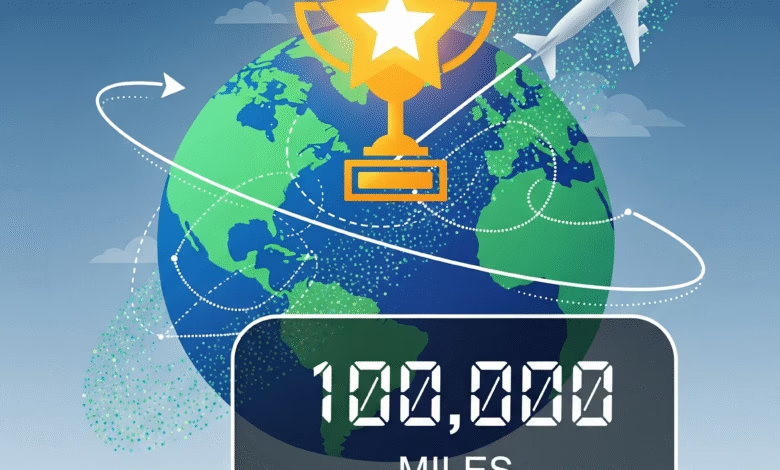
In the world of personal finance and travel, you’ve undoubtedly heard the term “airline miles.” People talk about flying across the world for free, securing luxurious business-class seats, and unlocking travel experiences that would otherwise cost thousands of dollars. But what exactly are these magical “miles,” and how can you start using them?
If you’ve ever felt like this is an exclusive club with a secret language, you’re not alone. The good news is that the concept is much simpler than it seems. This guide will demystify airline miles from the ground up. We’ll explore what they are, how they work, and the exact steps you can take to transform your everyday spending into your next great adventure.
How Do Frequent Flyer Programs Actually Work?

At its core, an airline mile is a form of rewards currency. Think of it as a “thank you” from an airline for your loyalty. The system was pioneered by airlines to encourage customers to fly with them repeatedly. They created Frequent Flyer Programs, which are loyalty programs that track your activity and reward you with miles.
When you create a free account with an airline’s frequent flyer program (like American Airlines AAdvantage®, Delta SkyMiles®, or United MileagePlus®), you receive a unique membership number. Every time you fly with that airline, you provide your number and earn miles based on the distance flown, the price of your ticket, or a combination of factors.
Once you’ve accumulated a certain number of miles, you can redeem them for a flight, effectively paying for the ticket with your miles instead of cash.
Are Airline Miles and Credit Card Points the Same Thing?
This is one of the most common points of confusion for beginners. While often used interchangeably, there’s a crucial difference:
- Airline Miles: These are the currency of a specific airline’s frequent flyer program. You can only earn and redeem them directly with that airline and its partners.
- Credit Card Points: These are the currency of a bank’s rewards program, such as Chase Ultimate Rewards® or American Express Membership Rewards®. These points are flexible and can often be transferred to many different airline (and hotel) frequent flyer programs.
Think of it this way: Airline miles are like a gift card to a single store, while credit card points are like a universal gift card you can use at many different stores. This flexibility is why general travel rewards credit cards are often considered the best starting point for earning free travel.
What Are the Best Ways to Earn Airline Miles?

While the name suggests you only earn miles by flying, this is no longer the primary way most people accumulate them. The world of miles has expanded dramatically, and you can now earn them from a vast array of activities.
1. Flying with an Airline
This is the original method. When you book a cash ticket, you provide your frequent flyer number to earn miles. The earning formula varies by airline; some award miles based on the distance you fly, while others use a revenue-based model where you earn miles based on how much you paid for the ticket.
2. Credit Card Sign-Up Bonuses
This is, without a doubt, the fastest way to accumulate a large number of miles. Travel rewards credit cards often offer substantial sign-up bonuses, sometimes providing 50,000 to 100,000 miles or more after you spend a certain amount of money within the first few months. A single sign-up bonus can be enough for a round-trip ticket to Europe or the Caribbean.
3. Everyday Credit Card Spending
Beyond the sign-up bonus, these credit cards will reward you for every dollar you spend. You’ll typically earn 1 mile per dollar on general purchases and accelerated rates (2x, 3x, or even 5x miles per dollar) on specific bonus categories like dining, travel, or groceries. By strategically using a rewards card for your regular expenses (and paying it off in full each month), you turn your budget into a mile-generating engine.
4. Using Online Shopping Portals
Nearly every major airline has an online shopping portal. Instead of going directly to a retailer’s website like Nike or Apple, you first click through the airline’s portal. You then shop as you normally would, and the airline rewards you with a certain number of miles per dollar spent, in addition to the rewards you earn from your credit card. This is called “double-dipping” and is a powerful way to accelerate your earnings.
5. Dining Rewards Programs
Airlines also have dining programs. You link your credit card to the program, and when you dine at a participating restaurant, you automatically earn extra miles.
6. Booking Hotels and Rental Cars
You can often earn thousands of bonus miles by booking your hotel stays or rental cars through an airline’s dedicated travel partners or booking portals.
How Do You Redeem Miles for Maximum Value?

Earning miles is the easy part; redeeming them wisely is what separates a good deal from an incredible one. Simply put, not all redemptions are created equal.
The goal is to get the highest possible “cent per mile” (CPM) value. You can calculate this with a simple formula:
CPM = (Cash Price of the Flight – Taxes/Fees) / Number of Miles Required
For example, if a flight costs $400 in cash, or 25,000 miles + $20 in taxes, the calculation is: ($400 - $20) / 25,000 = $0.0152. This means you’re getting about 1.5 cents per mile in value, which is a solid redemption.
Here are the best ways to redeem your miles:
- For Economy Flights: This is the most common redemption. While the CPM might be lower, it’s a fantastic way to significantly reduce the cost of your travels.
- For Business or First-Class Flights: This is where you find aspirational value. A business-class ticket to Asia might cost $8,000 in cash but could be available for 120,000 miles. This redemption yields a CPM of nearly 6.7 cents—an outstanding value that allows you to experience a level of luxury you might never pay for with cash.
- Avoid Redeeming for Merchandise or Gift Cards: Airlines will often tempt you to redeem your miles for toasters, magazines, or gift cards. These redemptions almost always offer a terrible value (often less than 0.5 cents per mile) and should be avoided.
Understanding the Power of Airline Alliances and Partners
No airline flies everywhere. To expand their global reach, they form partnerships and join one of the three major airline alliances:
- Star Alliance: (e.g., United, Air Canada, Lufthansa, Singapore Airlines)
- oneworld: (e.g., American Airlines, Alaska Airlines, British Airways, Cathay Pacific)
- SkyTeam: (e.g., Delta, Air France, KLM, Korean Air)
This is incredibly important for redemptions. If you have miles with a member airline, you can use them to book flights on any other airline within that alliance. For example, you can use your United MileagePlus® miles to book a flight on Lufthansa to Germany. This opens up a world of possibilities and greatly increases the utility of your miles.
Are Airline Miles Actually Worth Anything?

This is a fair question. The short answer is a resounding yes, but their value is not fixed. Unlike a dollar, which is always worth a dollar, the value of an airline mile depends entirely on how you redeem it.
As shown above, a mile can be worth 1.5 cents for an economy ticket or over 6 cents for a premium cabin seat. On average, a reasonable goal for most travelers is to get between 1.2 and 1.7 cents per mile in value.
The key is to view miles not as direct cash but as a tool to reduce travel costs and unlock experiences. They are a long-term savings plan for your travel goals.
Common Mistakes to Avoid on Your Miles Journey
As you get started, be mindful of these common pitfalls:
- Letting Miles Expire: Some (but not all) frequent flyer programs have expiration policies. Be sure to check the rules and have some account activity to keep your miles from expiring.
- Carrying a Balance on Your Credit Card: Earning 3% back in rewards is a terrible trade-off if you’re paying 20% in interest. The cardinal rule of rewards is to always pay your credit card bill in full and on time.
- Ignoring Sign-Up Bonuses: The bulk of your miles will come from these bonuses. Don’t miss out on the opportunity to start your journey with a massive head start.
- Hoarding Miles Indefinitely: Miles are a depreciating asset. Airlines can (and do) devalue their award charts, meaning the flight that costs 50,000 miles today could cost 60,000 next year. The best strategy is to “earn and burn”—save up for a specific goal and then book it.
By understanding these fundamental principles, you are no longer an outsider looking in. You have the foundational knowledge to start your journey, earn your first batch of miles, and take the first step toward making your travel dreams a reality.





